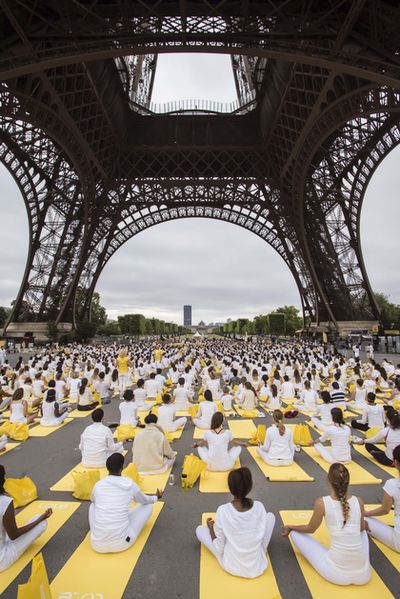At 7am on June 21, Prime Minister Narendra Modi arrived at Delhi's Rajpath dressed in all-white, with a tricolour stole and comfortable sandals. After delivering an impassioned speech on the significance of yoga, he led 35,000 enthusiasts on a unique yoga performance, which was replicated in a number of cities across India and the world. It all looked quite effortless, but the synchronous celebration of the International Day of Yoga across various centres was not an easy task. The work behind the project started last September, when Modi had asked the United Nations to declare June 21 as the International Day of Yoga during his speech at the annual session of the General Assembly.
Sanjay Vedi was one of the officers who put in a lot of effort over the past few months to make the event a success. Vedi, programme director in charge of the India culture centres wing of the Indian Council for Cultural Relations (ICCR), oversaw the selection of “yoga ambassadors” for the event. From April, he started shortlisting the names of yoga instructors to be sent to 30 important global destinations. Next came the job of choosing the high-profile venues in various world capitals, which was accomplished with support from the UN and the Indian missions in those cities.
 Celebration in Paris. As many as 192 countries took part in observing the day | AP
Celebration in Paris. As many as 192 countries took part in observing the day | AP
“Over the last three decades, yoga has been one of the three main cultural programmes alongside tabla and kathak that the ICCR has been teaching across the world, especially through its 35 culture centres abroad,” said Vedi. Yoga has remained an important component of the soft power element of Indian diplomacy since 1985, when prime minister Rajiv Gandhi took a large group of yoga instructors to the US for the Festival of India series. They travelled across the US, introducing thousands of Americans to yoga. “Since then, we have had a very active programme on yoga, which we have strengthened as we have to send the finest yoga instructors to the culture centres. Our preparedness ensured that we could come up with the trainers promptly,” said Vedi.
It was Vikas Swarup, the current spokesperson for the ministry of external affairs (MEA), who was given the task of coordinating the yoga day, when he was joint secretary in the UNP (United Nations Political) division of the ministry. “As joint secretary, my job was to shepherd the UN resolution on yoga till it was passed at the UNGA,” said Swarup, who was in New York with External Affairs Minister Sushma Swaraj. He worked with India’s permanent representative to the UN, the ICCR and the administration wing of the MEA to create a network of Indian diplomats who were at the forefront of the yoga day.
With the success of the event, Swarup said the MEA had a prototype to project Indian soft power globally. “After yoga, we plan to take up an array of India’s cultural gifts to the world, like ayurveda and medical tourism,” said Swarup. Alok Bansal of the India Foundation, a Delhi-based think tank, said medical tourism could be a major bonding agent in India’s ties with its south Asian neighbours. “India is the most popular destination for the Maldivians, Afghans, Bangladeshis and the Nepalese when they want to access quality medical treatment,” he said. “So there is a big reason to own up our advantages and represent them before the world.” The yoga day celebrations have also bolstered the hope for renewed economic growth. “A careful promotion of Bollywood, the tandoori cuisine and medical tourism can definitely throw up new economic opportunities at home and abroad, apart from providing greater appreciation for India and its cultural contribution to the world,” said Bansal.
An indirect benefit of the yoga day celebrations has been the warmer ties with the UN. The support extended by UN Secretary-General Ban Ki-moon was remarkable. He accompanied Sushma at the yoga day function at Times Square in New York. “The United Nations has an excellent network among member countries,” said Bansal. “We should not hesitate to use it innovatively whenever the opportunity arises.”
WITH SHALINI SINGH







